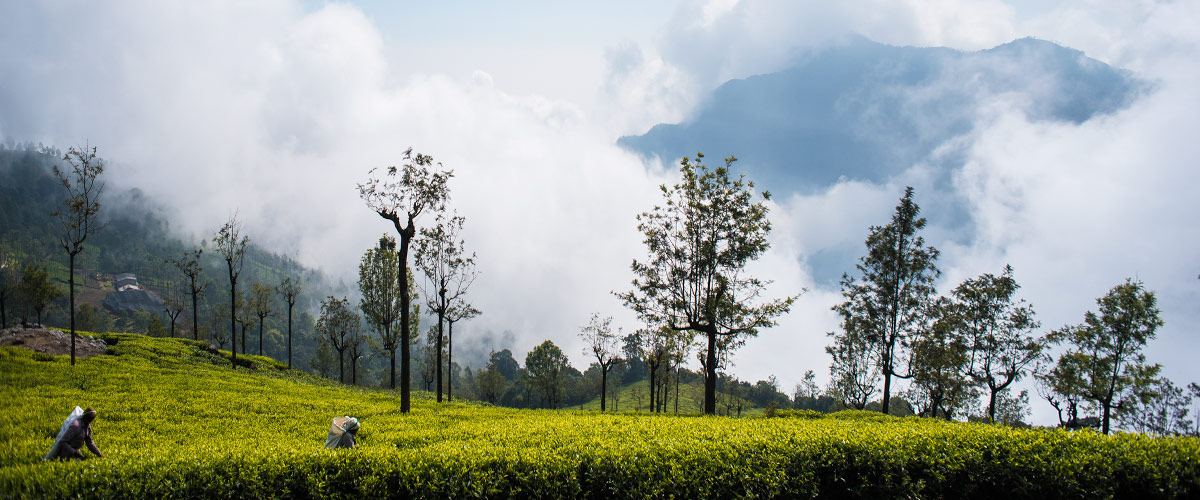Not all tea estates in India are a throwback to the colonial days. And in the Nilgiris, we found a rather interesting story at TANTEA or the Tamil Nadu Tea Plantation Corporation Limited.
We were en route to the Nilgiris and had stopped for breakfast at Channapatna, between Bangalore and Mysore, when Mr Sampath called. He is a visiting tea advisor with TANTEA and was calling to find out about our visit. On hearing we were already on our way, he invited us to their estate bungalow at Gudalur for the night.

I had assumed that Gudalur was lower in the hills and therefore expected it to be similar to the Dooars or Terai in the Darjeeling belt – flat lowlands. Instead I found myself headed uphill-Gudalur is at an altitude of 1000m. The views from here were stunning, as beautiful or more, I thought, than Darjeeling. And the bungalow, while not like the colonial-style bungalows seen in most tea gardens, was made of wood, a more typical guesthouse seen in government outposts.
TANTEA has an interesting back story. Back in the 1800s, there arrived a Scotsman, Gragham William McIvor, who was a gardener at London’s Kew Gardens. He was appointed Superintendent of the Ootacamund Botanical Gardens in 1848. [Ootacamund or Ooty is the main town in the Nilgiris.] McIvor is credited with successfully acclimatizing cinchona to India and ensuring a thriving production of it. This is of enormous significance because quinine used in the treatment of malaria is extracted from cinchona.
Now, McIvor needed labor for his cinchona plantation at Naduvattam and that was a challenge as there were not enough people available locally. So, he wrote to the British government and asked that 500 convicts be sent to work with him here. It took a year for the necessary sanctions but it led to the construction of the jail at Naduvattam.

The idea met with approval for a couple of reasons-lack of space in the jails in Madras, and more interestingly, the lower likelihood of convicts escaping from the hills. In 1866, 566 convicts arrived, including many Chinese prisoners of war from the Second Opium War, and even the Straits settlements of Singapore, Malaya, and Penang.

In 1876, McIvor died in Ooty. His cinchona plants continue to grow wild around here.
The story moves ahead almost a whole century. In the late 1950s tensions between the Tamils and Sinhalese in neighboring Sri Lanka erupted and several Tamils had to flee the country. They arrived in Tamil Nadu where in 1968, the government implemented the Government Tea Project. Under this, the now exiled Tamils were rehabilitated with jobs and a living at the tea gardens.

Because TANTEA’s tea gardens were built much after the British, you don’t see colonial bungalows or factories built in the typical style of the old days. In Naduvattam, which is now part of TANTEA, the old jail has been converted to a museum, although this tea garden is often referred to as the “jail thottam” or jail garden.
Also, perhaps because of the reasons for its inception, I saw fewer migrant workers here compare to others like Glendale or Craigmore. Most of the workers seemed to be local Tamils, or I imagine, descendants of the Tamil refugees.

The tea grown here is mostly CTC (Crush, Tear, Curl). The shears seen in the above photo is the kind used to harvest the crop for the non-specialty tea. Not the delicate hand plucking of two leaves and a bud. That’s reserved for their specialty silver needle teas. The standout feature of the silver needle is that they are not machine dried but allowed to dry in the sun even though it takes longer.

The estates follow multicrop farming which is quite evident as you walk around the estate. Pepper is quite common, and in estates like Glendale, even flowers like geranium used in their tea blends, are grown.

On every visit to a plantation I try and gather information on different cultivars. So while here, I asked Mr. Sampath about the clones they use at TANTEA. And he told me about Dr. Venkataramani, a legend in the tea fraternity in these parts. Dr. Venkataramani was the Director of UPASI in 1960 and among his achievements is the unique triploid clone B/5/63, originally named Sundaram in memory of his father. This clone, rarely blossoms, but produces yield almost double that of any other variety.
My visit to TANTEA has changed some of my own perceptions and reaffirmed others. This is a government-owned estate and one tends to assume some disdain or doubt about the quality attributed to the produce. But TANTEA is run as well as any of the private estates. The staff here seemed passionate about what they do, interested in tea and interested too in understanding more about it. Most of the staff I interacted with at TANTEA were well into their 50s, and have worked here for a really long time. But any conversation about their teas quickly transformed them; they spoke with a genuine happiness and a lot of pride, like a parent showing off a newborn child, I thought.

